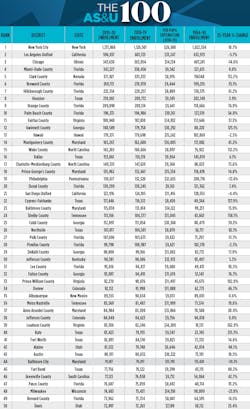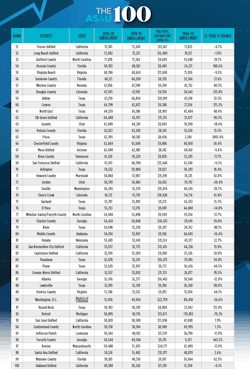Are large school districts organizations that can take advantage of economies of scale to operate more efficiently as they educate thousands of children? Or are they oversized operations that are saddled with too many bureaucratic twists and turns to focus effectively on student learning?
Probably some of both, and at the same time. Running a school system can be challenging, as anyone doing so in the time of Covid-19 can attest. As the numbers of students increase, the challenge becomes more daunting. Superintendents in the largest districts often don’t last very long--just within the last few months, the top administrators in the nation’s three largest districts resigned after brief stints—about three years for each of them.
Regardless of how one views large districts, the facts show that over time, the largest districts are becoming larger.
The 2021 AS&U 100, a compilation of enrollment data from the 2019-20 school year, shows that the 100 largest districts accounted more than 11.1 million students. Twenty-five years earlier, those districts had a little over 9 million students.
The enrollment figures in the AS&U 100 are gathered from fall 2019 data posted online by state education departments and individual districts. Those numbers often differ from those found in federal figures or other sources—in some cases, state numbers will include charter school enrollment in a district’s total, but federal numbers do not.
The fall 2019 numbers also do not reflect the situation that arose later in 2019-20 when the Covid-19 virus shut down nearly every school across the nation.
Florida, Texas and California
As has been the case for many years, the list of the largest districts is dominated by three states—Texas, Florida and California. They are the states with the largest populations, according to the 2020 U.S. Census, and they account for 47 of the 100 largest districts—20 in Texas, 15 in Florida and 12 in California. (When the list is expanded to the 200 largest districts, Texas, Florida and California also dominate that part of the list. Texas accounts for 23 districts ranked 101 to 200; California accounts for 13, and Florida 10.)
Whether a district is large enough to appear on the AS&U 100 depends on how districts are formed. In Florida, school districts are countywide entities, so their districts tend to be larger—five of the nation’s top 11 districts are in the Sunshine State.
In other areas, districts cover smaller geographical areas—24 of the 50 states do not have any districts among the 100 largest.
From year to year, the roster of the 100 largest districts changes hardly at all. New York City, the nation’s largest municipality, is by far the largest public school system with more than 1.1 million students.
But when the numbers are compared with figures from 25 years ago, significant changes can be seen.
Between 1994 and 2019, 13 of what are now the 100 largest districts doubled their enrollment. The fastest growing of those was the Frisco (Texas) district, which was 29 times larger in 2019-20 than it was in 1994-95. The numbers mushroomed from 2,160 to 62,705 students. It had four schools 1993 and now has more than 70. Among the districts ranked 101st to 200th in size, 20 of them doubled in size from 1994 to 2019.
Several districts, mostly in large cities, saw their enrollment plummet over the last 25 years. In many cases, they have lost students to charter schools, which were rare in 1994.
MORE: Where are the next 100--the districts ranked 101st to 200th in enrollment? Click here.
Higher Education
At the higher-education level,enrollment is not necessarily controlled by population trends in the vicinity--a college or university can decide to limit or expand enrollment based on its own specific circumstances.
Even before Covid-19 forced an abrupt shift to virtual instruction, many students were turning to online programs to pursue their degrees. In fall 2019, many of the institutions with the largest enrollments are ones that have robust online programs that can attract students without geographical limitations. Western Governors University, based in Salt Lake City, Utah, topped the list with 136,139 students.
About the Author
Mike Kennedy
Senior Editor
Mike Kennedy has been writing about education for American School & University since 1999. He also has reported on schools and other topics for The Chicago Tribune, The Kansas City Star, The Kansas City Times and City News Bureau of Chicago. He is a graduate of Michigan State University.


